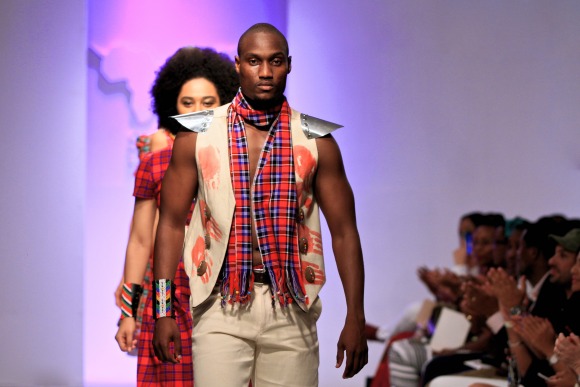By
Sampson Onwuka
Swahili Fashion Week 2016
The successful 2015 fashion week in Swahili leads the case
for 2016. Once more some of the interesting couturiers and traditional tailors
show their worth in an all African Showcase. December 2nd through the 4th
Swahili brand of the African designers will be the toast of the Continent. The
designer we are may be interested in Gabriel Mollel. He is an African designer
and some of his design signature is imitation of tribal garb for consumption. Gabriel Mollel like other Africans is face with challenge of re-populating the fashion diversity.

Gabriel Mollel
.JPG)
Gabriel Mollel @ Swahili Fashion Awards

@Gabriel Mollel

@Gabriel Mollel courtesy of Fashionghana
2015 Swahili is a reaching success for the range of talents
that managed to grace the show and for 2016, the stakes are not lower. 2015
represents a departure from earlier attempts at the Swahili Fashion week which
was founded by ‘Mustafa Hassanali’ in 2008 with the mantra of representing ‘East
African’ fashion industries and the ‘Made in Africa’ ‘couturiers’. 2015 Swahili
fashion week brought East Africa to the attention of Africans.

A challenge of an industry

We may look at the ‘made in Africa’ as a motivation for
founders – for this, it has gravity. It lends to a crusade which does not
easily translate to sale largely for the general theme of promoting a ‘made in
Africa’ and thin emphasis on ‘East Africa’ which is translucent. As an outcome,
we natural look for the new translation of traditional African garbs into forms
readily available for consumptions. The Lagos Fashion week suffered its
problems of exposure but there are brands names that are yet to migrate from
African traditional attire to custom products by indigenous tailors. The crass
view of the new products showcased during the fashion week lack some of the pedigree
in gifted tailoring. The full measure of the designs and cloths in terms of traditional
wear show the struggles with making the cloths and not necessary the technology.
One of the enduring problems of organizing fashion week is
conflict over scheduled showcase and the different houses of fashion who
sometimes labor with new materials. Many of the stores have the problems of
execution following the first 3 weeks a fashion week and there are question of
delivery if the demand increases. There is reason to believe that this is a
general problem with the industry but in relative African fashion environment,
there are other material issues of coverage.
Any given designer with some standing in business will
retail at fifty tailors for lead design/s and the rest are arranged for the
factor workers. For African businesses, the issues of distribution and the
price range prove an obstacle in having a close-out of new trends. For that
high fashion is profitable in select African countries and for Swahili and Dar es
salaam, Tanzania, there are reasons to expect more in 2016 from a 2015 grow
show. There are number of remedies for problems like this, one of which is to
have multi-channels for latest designs and for tailors to show their interest
without losing their hallmark.
The other solution is primarily a question of media houses,
for instance, the names of the leading tailors or designers may be gifted a
great opportunity to showcase their cloths. It may entail working with other
tailors and photographers from other fashion environments, and it may involve
awards for the better tailors and workers in the industries. A fashion
statement is an idea translated differently. Cloths from African tailors lack leads and
lack hints of distinction.
No comments:
Post a Comment